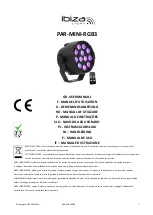
9
Risk of injury from breakage of glass with collision
Depending on the size of the flask, the setting angle of the rotation drive and the position of
the heating bath and lift, the evaporator flask may be in contact with the bottom of the heating
bath�
�
Set variable end stop to limit the lower lift position�
Risk of injury through toxic / corrosive gases or suspended particles
The open outlet at the cooler may allow gases, vapours or suspended particles to escape in
hazardous concentrations�
�
Make sure that any risk is ruled out, e�g� with downstream cold traps, gas wash bottles or an
efficient extraction system�
Risk of burns from glass vessels
The evaporator flask and glassware assembly can become hot during operation and remain so
for a long time�
�
Do not touch hot glass vessels without personal protective equipment�
�
Allow components to cool off before continuing work with the device�
Risk of burns from splashing with hot tempering media
Do not operate the device when the evaporator flask is rotating and the lift is raised�
�
Adjust the speed of the drive to prevent tempering medium being ejected from the heating
bath by the rotating evaporator flask�
Risk of crushing from rotating parts
�
Do not reach into rotating parts�
Risk of injury from delay in boiling
Heating the evaporator flask in the heating bath without connecting the rotary drive may delay
boiling�
�
Connect rotary drive to avoid delay in boiling�
�
Sudden foaming or exhaust gases indicate that flask content is beginning to decompose�
Switch off heating immediately�
�
Lift the evaporator flask out of the heating bath using the lifting mechanism and ventilate the
system to normal pressure as appropriate�
�
Clear the hazardous area and warn any persons in the vicinity�
Risk of injury caused by electric shock
�
Only put together accessories with the power supply cable disconnected�
Risk of injury caused by explosion
�
Do not use the device in explosive atmospheres, as it is not EX-protected�
�
When using tempering media that could create explosive mixtures, take appropriate safety
measures (e�g� work under an extractor hood)�
Risk of injury through explosive decomposition of peroxides
Organic peroxides can accumulate in distillation and exhaust residues and explode while
decomposing� Numerous organic compounds are liable to form peroxides, e�g� dekalin, diethyl
ether, dioxane, tetrahydrofuran (also unsaturated hydrocarbons such as tetralin, diene, cumene
and aldehydes, ketones and solutions of these substances)�
�
Avoid peroxide formation�
�
Keep liquids that are liable to form organic peroxides away from light (in particular UV rays)�
�
Check liquids for peroxides before distillation and exhaust�
�
Eliminate any peroxides present�
Содержание RV 3 eco
Страница 1: ...RV 3 eco...
Страница 2: ......
Страница 3: ...ENGLISH...
Страница 4: ......
Страница 18: ...18 H L 2 1 2 3 H 1 2 C 1...










































